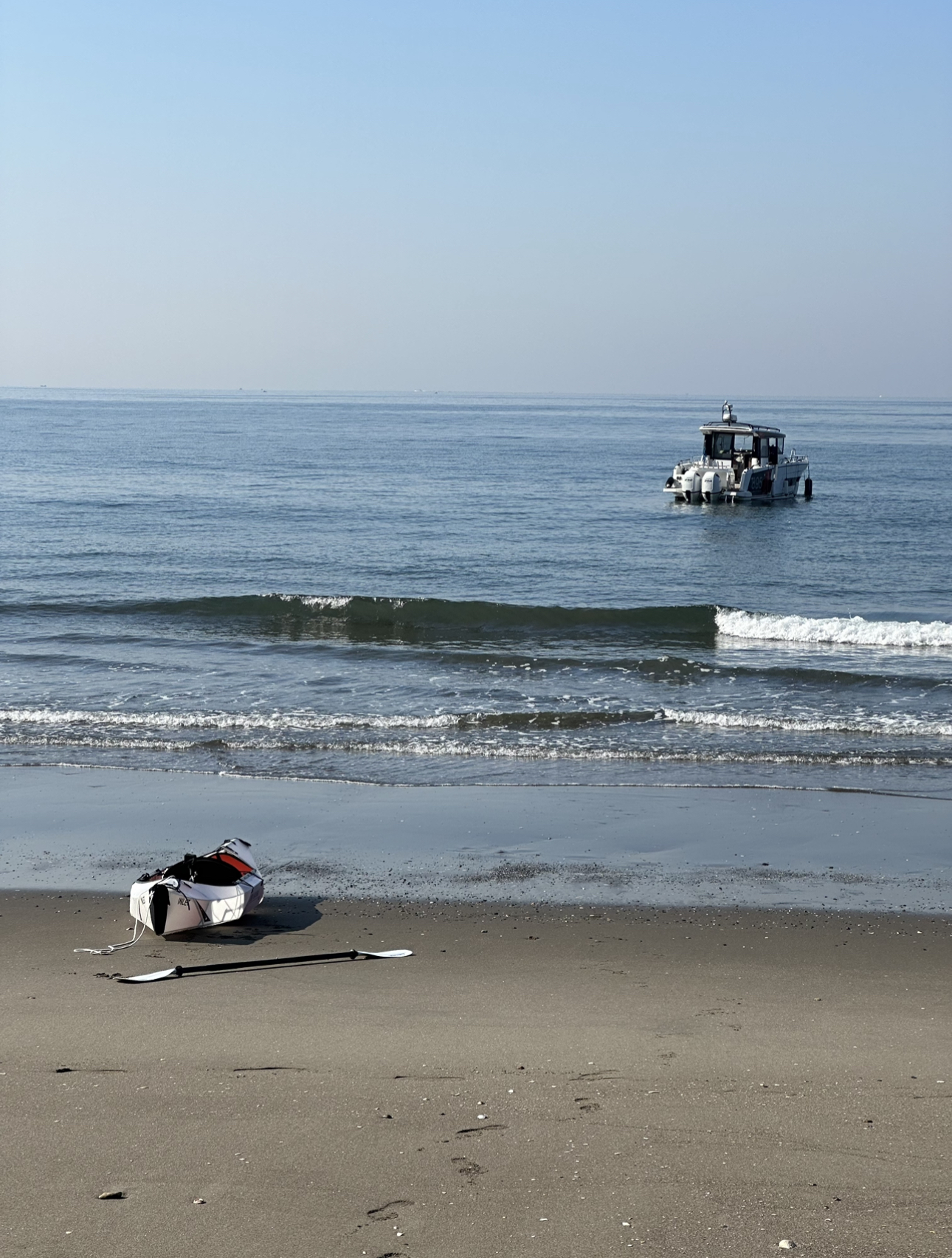This time, landing on a wonderful beach, not a typical swimming area, that I found in a certain location in Tokyo Bay is a topic.
It’s hard to convey just how wonderful it is through pictures, and I apologize that I only have these four photos at the moment.




Upon checking various maps, it seems that this beach has poor accessibility by land. It requires a considerable walk from the nearest parking lot, so the number of people attempting to reach this beach is likely to be low.
In reality, I encountered a total of three pedestrians on this beach, all serious fishermen wearing waterproof overalls and equipped with long poles. Given that it’s not a swimming area, it’s natural that there are very few people.
The beach is surrounded by cliffs, and the coastline forms a gently curving inlet, minimizing the impact of wind and waves. The seabed is shallow sandy terrain, making anchoring easy.
Anchoring, contemplating, and playing with rechargeable power tools have become stress-relief methods for Rikutsu-Kone-Taro’ on his boat recently.
No matter how much noise he makes, it doesn’t disturb anyone.
During multiple solitary moments in such a wonderful place, a desire to land on the beach from the boat gradually emerged. Perhaps it’s because humans are fundamentally terrestrial creatures, having evolved from ancestors who transitioned from the sea to the land in ancient times.
While swimming across to the shore is an option since anchoring is in waters only tens of meters from the shore, it lacks creativity, gets one wet, and limits the transportation of toys, camping gear, and power tools for beach activities.
Even though it’s currently a warm October, there might be a desire to land in winter as well.
So, the idea of preparing something like a tender boat came up.
The requirements were clear: it should not require registration, be compact when disassembled or folded, fit into the storage space of my boat, be lightweight, easy for one person to assemble at sea, and have reasonable carrying capacity.
For now, human power will be the means of propulsion.
While there are many inflatable or assembleable kayaks and canoes on the market, I decided to go with a product from ORU KAYAK.
ORU KAYAK constructs a boat structure by folding a cardboard-like plastic sheet into a three-dimensional form when in use. When stored, it folds back into a compact state by folding it into three sheets, much like origami—an ambitious product indeed. (For details, click here for an external site.)
It looks quite cool, matching the aesthetics of ‘Logical Connection Taro’s’ beloved boat. After all, looking cool is important in everything.



While it might have weaknesses in terms of durability, weather resistance, and wave resistance compared to other products, I found value in its compact storage and the ability to prepare it easily on my boat at sea. Therefore, for this time, I chose an ORU KAYAK product. Rikutsu-Kone-Taro’ is a solo sailor.
Among the various ORU KAYAK products, I chose the Inlet model based on considerations of size, carrying capacity, lightweight, and price.
This product can be stored on my boat at all times, has a short preparation time, is lightweight, and seems like it will broaden the scope of future adventures by allowing me to use it immediately when the mood strikes.
The following photos show the folded kayak stored under the stern deck space (where the engine is located in a motorboat)

 The paddle is a two-piece design, and I decided to use my Gore-Tex top and bottom to wear, allowing for some wetness tolerance.
The paddle is a two-piece design, and I decided to use my Gore-Tex top and bottom to wear, allowing for some wetness tolerance.
The day after purchasing all the necessary equipment, including the kayak, from a Mont-Bell store near my home, I decided to execute the beach landing operation.
And here are the photos of the successful operation on the day. Getting from the boat to the kayak is a bit challenging.

Oh, what a delightful situation it is! Alone in the clear water near the shore.



I didn’t notice it when anchoring, but upon reaching the beach, I was amazed by the clarity of the water. The water at the shore, whether it’s due to the cliffs approaching the beach or the coastline forming a gentle inlet, was remarkably clean. Once the water reached ankle height, the slight chill created a refreshing sensation, making it quite enjoyable.
On the way back, I loaded the kayak onto the boat like this and headed to the home marina.
Upon returning to the marina, I rinsed the kayak with fresh water, dried it in the sun, and folded it compactly for storage under the deck.
Landing operations to places other than mooring facilities—a desire I’ve had for a while. The first attempt was successfully completed without any major issues.
Next time, I plan to land with tea, food, sunshade fabric, and spend a bit more leisurely time.
Of course, I’ll be mindful not to cause inconvenience to nearby residents or fishermen, keep a distance from anglers, and make an effort to leave the area cleaner than when I arrived.
